Mark Sisson's Blog, page 202
November 23, 2016
Gift Bundle Offer EXTENDED for The New Primal Blueprint!
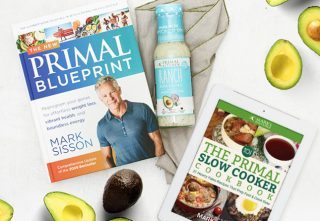 Good morning, everybody. Just a quick announcement here before we return to our regular health programming…
Good morning, everybody. Just a quick announcement here before we return to our regular health programming…
I know some folks have had problems getting Kindle or (in some countries) hardcover copies of The New Primal Blueprint. We’ve been working tenaciously with our distributor to get this issue resolved ASAP.
While we hope it will be fixed today, I want to make sure no one misses out on the outstanding gift bundle we’ve had going just because of a glitch. So, I’ve EXTENDED the FREE GIFTS offer until November 27th at midnight (PST).
In addition to this 584-page, full-color and thoroughly updated beast of a comprehensive health guide, you’ll get the following items:
A coupon for a free bottle of PRIMAL KITCHEN™ Ranch dressing at PrimalBlueprint.com:
Use this form to receive a coupon for a FREE bottle of our newest PRIMAL KITCHEN™ creation and the holy grail of dressings: ranch! This dairy-free ranch is an uncompromisingly delicious, rich, full-flavored, and oh, so healthy dressing. Using 100% pure avocado oil as a base, our ranch includes only the finest health-enhancing, all-natural ingredients, including organic garlic, onion, dill, cage-free organic eggs, black pepper and chives. And that means no dairy, no buttermilk, gluten, soy, canola or sugar in sight. So go ahead and finally enjoy your childhood favorite again! No guilt here.
A digital download of The Primal Slow Cooker Cookbook:
I know you folks are busy with the kids and work and workouts, so I’ve put together this collection of broths and slow-cooked, nutritious and delicious meals that will be ready for eating when you walk through the door. Enjoy creations like Chicken Adobe with Coconut Aminos, and Tender Braised Brisket with Caramelized Onions and Tomatoes.
Just click here to grab your copy of The New Primal Blueprint on Amazon and fill out this form to get your free bonuses.
Just a quick reminder on the FINE PRINT…
This special bonus offer ends at 11:59 pm, Nov. 27, 2016 (PST).
All receipts must be received by 11:59 pm, Nov. 28, 2016 (PST). The forms will stop working on Nov. 28, so be sure to fill out the form and submit your pre-Nov. 27 receipt(s) by then.
On an iPhone? You won’t be able to upload your receipt from it, unfortunately. You’ll have to use a computer.
You will receive access to The Primal Slow Cooker Cookbook and your PrimalBlueprint.com gift certificate via email within 24 hours.
Pre-orders will be honored for all bonus offers.
Both orders placed online (from any source) and in brick and mortar retail locations will be honored.
Both domestic (U.S.) and international orders are eligible for the bonuses.
All book formats are eligible, including physical books and digital versions (e.g. Kindle).
The PrimalBlueprint.com gift certificate expires on December 23, 2016, and is valid for a single use on one bottle of PRIMAL KITCHEN™ Ranch dressing, you just pay S&H.
Thanks for your patience, everyone! I hope this book becomes yet another tool in my personal mission to help 10,000,000 people create better health and vitality for themselves. For yourself, for those you love this holiday season—enjoy!
The post Gift Bundle Offer EXTENDED for The New Primal Blueprint! appeared first on Mark's Daily Apple.



November 22, 2016
5 Common Prescriptions That Should Require Nutritional Counseling
 I’m not a drug denier. For the most part, at the base level, pharmaceuticals do what they’re supposed to do. Statins lower cholesterol. Beta-blockers lower blood pressure. Antibiotics kill bacteria. Whether those changes save lives or reverse disease is another question entirely. But we can all agree that pharmaceuticals deserve a place in modern medicine. And even if we don’t, they objectively have a place, and we must acknowledge reality.
I’m not a drug denier. For the most part, at the base level, pharmaceuticals do what they’re supposed to do. Statins lower cholesterol. Beta-blockers lower blood pressure. Antibiotics kill bacteria. Whether those changes save lives or reverse disease is another question entirely. But we can all agree that pharmaceuticals deserve a place in modern medicine. And even if we don’t, they objectively have a place, and we must acknowledge reality.
We can also agree that many of the most common prescription drugs affect the way we absorb, metabolize, utilize, and excrete vitamins, minerals, and other important health co-factors. People taking them deserve nutritional counseling. This is my quick and dirty attempt to encourage that.
Please note that none of my advice is medical. I can’t speak to anyone’s personal circumstances and, therefore, can’t call this nutritional counseling or advice for your individual case. That said, research as always demonstrates patterns, and these aren’t always given their due in the course of prescription-writing or even follow-up exams. If you wish to discuss the following findings with the person prescribing you a drug, print out or email the references to which I link. Linking to the blog would be easier, but in my experience “this blog I read” is anathema to most MDs.
If you want to skim the nutrients affected, just look for the bolded lines.
Let’s go:
Statins
Statins don’t just reduce cholesterol production. Statins reduce cholesterol by inhibiting the HMG-CoA reductase enzyme pathway that lies upstream of cholesterol synthesis. But here’s the problem: lots of other biological compounds lie downstream of HMG-CoA, not just cholesterol.
When you block HMG-CoA reductase, you also block production or synthesis of several important nutrients:
CoQ10, which is important for cellular energy (ATP) production. Without CoQ10, our muscles and heart are really bad at contracting. CoQ10 deficiencies have been linked to heart failure and hypertension, and supplemental CoQ10 can counter statin-induced muscle wasting.
Vitamin K2, which is protective against cardiovascular disease, osteoporosis, and tooth decay. Totally expectedly, the sites where statin-related adverse effects occur (brain, kidney, pancreas, muscles) mostly happen to be storage sites for vitamin K2.
Squalene, which the liver produces en route to producing cholesterol. However, it’s not just a precursor. Squalene also has antioxidant effects and forms part of the lipid barrier along the skin protecting us from the environment.
And since we use cholesterol in the skin to produce vitamin D upon exposure to UV light, blocking HMG-CoA in a roundabout way blocks vitamin D production.
Testosterone is another innocent bystander. We need cholesterol to make testosterone. I bet a few egg yolks a day might improve a statin-user’s health.
Hormonal Birth Control
I’ve written about hormonal birth control before, covering both the benefits and the health risks. One risk I didn’t mention last time was the threat of nutrient depletion. For decades, researchers have found correlations between BC usage and several key nutrient deficiencies. Whether each relationship is causative remains to be seen—BC usage may be higher in groups with lower nutrient intakes—but the consistency of the relationships and the fact that supplementing the nutrient often improves health suggests something is going on.
Which nutrients are we talking about?
Vitamin B6: Low-dose BC seems to negatively affect vitamin B6 status.
Vitamin B12: Two factors seem to decrease B12 absorption in BC users—greater degradation of B12 in the gut and lower B12 binding capacity.
Vitamin C: Giving vitamin C (and E) to women using BC reduces lipid oxidation and improves glutathione status.
Vitamin E: BC users have lower vitamin E levels; supplemental vitamin E normalizes platelet function in BC users.
Folate: BC use seems to increase folate excretion through the urine and impair folate metabolism in the body. Although eating enough folate should counter these issues, few people eat the requisite amount of greens and liver and other things to do it. Some contraceptives now come with folate included, and they seem to do the trick. Other researchers think low-dose BC doesn’t really affect folate status (or B12, for that matter).
Selenium and zinc: Giving healthy women oral BC significantly reduces zinc status and moderately reduces selenium.
Magnesium: BC directly lowers serum magnesium levels in humans. And in rats, supplemental magnesium ameliorates BC-induced glucose intolerance.
Proton Pump Inhbitors (PPIs)
Whether you’ve got peptic ulcers, acid reflux, or basic indigestion, your doc may prescribe a PPI. These do what they’re meant to—inhibit the function of the proton pumps that produce stomach acid. If you have “excess stomach acid,” shutting these pumps off can ease the burn. But we need adequate stomach acid to absorb the nutrients in our food.
PPI users are particularly at risk for impaired absorption of B12, iron, calcium, magnesium, and vitamin C. Long-term PPI usage is consistently associated with poorer bone health, thanks both to impaired bone-centric nutrient absorption and reduced proton pump activity in bone cells.
Another victim of PPIs are the gut bacteria. The stomach is acidic by design/selection; it’s a strong barrier to entry. By reducing stomach acidity, PPIs alter the pH of the gut and allow alkaline-preferring microbes to survive digestion and set up shop in the gut. PPI users are more likely to have bacterial overgrowth from these unwanted invaders in their guts.
To counter this, PPI users can consider taking probiotics and n-acetylcysteine. In one study, PPI users who took both n-acetylcysteine and a blend of 4 probiotic strains (L. rhamnosus, L. plantarum, L. plantosus, and L. delbrueckii) reduced bacterial overgrowth.
Perhaps a good addition would be a high-quality yogurt, which provides probiotics and calcium and has been shown to improve bone health in PPI-taking rats.
Beta Blockers
Beta blockers are the elders of the antihypertensives. They reduce blood pressure by reducing the strength of your heartbeat, which sounds incredibly archaic. If that isn’t the prime example of treating the symptom with brute force, nothing is.
One way to reduce the strength of the heartbeat is to impair production of the nutrient responsible for energy production in the heart: CoQ10. Just like statins, beta blockers block CoQ10, only this time it’s the desired effect. Take CoQ10 to counter this.
Beta blockers also block melatonin secretion at night. And sure enough, sleep disturbances are a common side effect of beta blockers. In a cruel twist of fate, poor sleep can increase the risk of the condition beta blockers are treating: hypertension. Take 0.25-0.5 mg melatonin a half hour before your bedtime.
Metformin
The glucose-reducing drug metformin isn’t just for diabetics these days. A number of otherwise healthy people take it to inhibit mTOR and hopefully extend lifespan. Type 2 diabetics (a population with lower overall mortality) who take metformin live longer than age-matched controls who don’t have diabetes, for example.
Metformin also protects against the conditions that kill people, like cancer. It lowers hyperinsulinemia and may protect against insulin-related cancers (breast, colon, etc).
But if you’re going to take metformin, you should also consider supplementing with vitamin B12. B12 deficiency is incredibly common in people taking metformin, and researchers are even suggesting that B12 monitoring become standard care for metformin patients.
A good general rule for folks on the standard Western cocktail of statins, antihypertensives, PPIs, and metformin with the occasional round of antibiotics?
CoQ10, 200-300 mg (or eat lots of beef heart).
A good B-complex, particularly B12 and folate.
Melatonin at night, 0.25-0.5 mg.
Magnesium, 200-400 mg (or lots of leafy greens, some nuts and seeds, some blackstrap molasses, maybe even legumes).
A couple Brazil nuts for selenium.
Eat oysters and red meat for zinc.
A few egg yolks.
A good probiotic.
Fermented dairy (yogurt, kefir, cheese) for the calcium and probiotics. Fermented food in general (sauerkraut, kimchi, fermented condiments and sauces).
Hell, that’s not a bad lineup for anyone. But do take these to heart. Even if you’re not taking any drugs, someone you know and love probably takes one or more daily and could really use a nudge in the right direction.
Chances are, this will be the first they hear of it.
That’s it for today, everyone. Now I’d like to hear from you. What other drugs interact with vitamins and minerals in our diets? Are there any other nutritional considerations people taking prescription drugs should heed?
Thanks for reading!
The post 5 Common Prescriptions That Should Require Nutritional Counseling appeared first on Mark's Daily Apple.



November 21, 2016
Dear Mark: New Primal Blueprint Edition Comments, and Is Healthy Living a Placebo?
 For today’s edition of Dear Mark, I’ll first be addressing questions from the comment section of the new Primal Blueprint edition announcement, plus one from the placebo post.
For today’s edition of Dear Mark, I’ll first be addressing questions from the comment section of the new Primal Blueprint edition announcement, plus one from the placebo post.
The first question comes from barry and concerns the omission of raw food on the new PB food pyramid. Did I make a mistake by not including overt recommendations for eating raw veggies and meat? Are cooked foods responsible for our health problems? After that, I field a brief question about non-running alternatives for the MAF method. And finally, I explore whether healthy living is all just one big placebo.
Let’s go:
I love your dieting aspects as well, although, I haven’t heard you or anyone else really address the benefits of eating raw. The only people I can find that address this is the WAPF. I eat raw animal products daily and I was surprised to see this hasn’t really been discussed much. Raw meat, raw eggs, raw dairy, raw plants, etc. it’s all good for you. Humans are the only animal that cooks their food yet we’re the sickest.
Thanks for the kind words, barry.
I’ve spoken glowingly of raw dairy. I’ve explained how the raw dairy proteins can boost immune function and increase glutathione synthesis.
I’m also supportive of raw egg yolks. Those fatty acids and cholesterol can be fragile, especially if they’re battery-raised, conventional eggs (pastured are more resistant to heat), and a good raw egg yolk is to be savored, in my opinion. I like them separated and dropped into smoothies, sauces, or blenders full of coffee, or consumed in the context of a sunnyside-up egg.
I eat a large bowl of mostly raw plants almost every day: my Big Ass Salad. While heartier greens like kale and chard are more digestible when cooked, I think there’s value in eating a mix of raw and cooked vegetables.
Raw meat can work, sure. Steak tartare, sashimi, poke, liver smoothies. Raw meat is quite digestible, but not uniquely so.
Humans are also the only animal to wield fire, wear clothing, participate in spiritual rituals, and—yes—cook. We are unique animals. And there’s considerable evidence that cooking increased the availability of calories, reduced the amount of labor and chewing required to obtain them, and triggered the brain growth spurt that enabled our ascension to the top of the food chain.
I’ve written about the potential dangers of the carcinogens and toxins that form during certain types of cooking. I’ve also discussed our likely adaptation to some amount of these toxins in our diet. There may even be hormetic benefits to occasionally consuming foods cooked at high heat.
I haven’t come across any quality evidence that cooked foods are major contributors to the degenerative diseases afflicting humans.
I just started looking into MAF, but I cannot run. I do a brisk walk on the treadmill. All the self testing seems to be aimed at runners. Not sure if I can accurately self test…
You can.
The MAF method works with anything. You can row, hike, bike, or swim. You can hop on the elliptical, the gazelle, the recumbent bike, or one of those weird vehicles that looks like an elliptical on wheels. Anything works. Just move.
If you can hit the numbers briskly walking, it will work.
Finally, from the placebo post:
So this primal lifestyle we’ve embraced … ?
HealthyHombre broaches an important question. Could “healthy Primal living” be one big placebo effect?
Maybe. Partially.
We know that the placebo effect worms its way into everything we do.
When people are told they’re drinking a 620-calorie “indulgent” shake that’s actually just 300 calories, their postprandial ghrelin—a hormone that increases hunger and generally drops after large calorie intakes—plummets. As if the shake was indulgent and high in calories…
When non-exercising housekeepers are split into two groups—one group told their daily duties are a great way to exercise, the other told nothing—the “exercising” group loses weight and improves their blood pressure despite no change in activity levels.
I think it’s a case of placebo + real effect. This way of eating, living, and training really does work. Clinical trials (placebo-controlled ones!), anecdotes, and common sense confirm it. Food has hundreds of physiological effects. Exercise stresses the body and provokes an adaptive response. Sunlight does produce vitamin D, spending time in nature does reduce stress and boost immune function. These are all real things happening.
But belief in what you’re eating and doing has to have benefits. If believing a sugar pill can improve your IBS works, believing your salad is good for you probably has helpful effects above and beyond what’s actually in the salad.
Living a healthy Primal lifestyle physically and embracing it psychologically might just offer the best of both worlds. In my experience, real emotional investment makes living against the grain easier anyway.
That’s it for today, folks.
I’d love to hear your thoughts down below. Take care!
The post Dear Mark: New Primal Blueprint Edition Comments, and Is Healthy Living a Placebo? appeared first on Mark's Daily Apple.



November 20, 2016
Weekend Link Love – Edition 427
 Research of the Week
Research of the WeekWall sits reduce hypertension.
Resveratrol could replace sulfites in wine-making.
Teens who stay up late have less self-regulation.
Blood from human teens rejuvenates aging mice.
The link between produce consumption and better cognitive function is mediated by physical activity.
New Primal Blueprint Podcasts
Episode 143: Jimmy Moore: Host Elle Russ chats with prolific low-carb author, podcaster, and evangelist Jimmy Moore.
Each week, select Mark’s Daily Apple blog posts are prepared as Primal Blueprint Podcasts. Need to catch up on reading, but don’t have the time? Prefer to listen to articles while on the go? Check out the new blog post podcasts below, and subscribe to the Primal Blueprint Podcast here so you never miss an episode.
Promises and Limitations of the “Personalized Care” Movement: Where We Are Now
Can You Harness the Placebo Effect For Yourself?
Interesting Blog Posts
How much meat and protein are we actually eating?
Are you on a hunger-free diet?
Media, Schmedia
The hits keep coming for Theranos.
According to the new statin guidelines, everyone over 40 is at imminent risk for a deadly heart attack. Luckily, there’s a wonder drug for that!
Everything Else
Vegans are focusing their activist ire on a true titan of industrial animal cruelty: a primitive skills expert who teaches a class on humane slaughter.
Data miners plumbed a global database of recipes for correlations between different cuisines and health, finding a “clear correlation between obesity and cuisines that are dominated by sugar and carbohydrate.”
Things I’m Up to and Interested In
Concept I’m playing with: Free will (or lack thereof).
Movement that impressed me: This casual side lever pull.
Articles I’m pondering: “Neoliberalism is creating loneliness. That’s what’s wrenching society apart” by George Monbiot.
Announcement I’m pleased to, well, announce: The new edition of The Primal Blueprint!
Science development I’m : Scientists are growing tiny lungs, hearts, and other tissues from stem cells to study complex human diseases, track gene function, and build the next generation of realistic action figures.
Recipe Corner
A roundup of Primal Thanksgiving sides.
Mayo-roasted turkey. Sounds weird, but it’s good (especially if you don’t skimp on the mayo).
Time Capsule
One year ago (Nov 20 – Nov 26)
5 Responses When Relatives Ask Why You’re Not Eating Stuffing This Thanksgiving – Prepare yourself.
How Bad is Charred Meat, Really? – Is it gonna kill me, doc?
Comment of the Week
“Everything the light touches is our kingdom…”
– You got that right, ericle2. (From Mark’s Daily Apple on Instagram)


The post Weekend Link Love – Edition 427 appeared first on Mark's Daily Apple.



November 19, 2016
White Chicken Chili
 White chili is called white chili for three reasons. One, it’s made with chicken, not beef. Two, it’s made with white beans. Three, it’s sometimes thickened with milk and flour, or cream.
White chili is called white chili for three reasons. One, it’s made with chicken, not beef. Two, it’s made with white beans. Three, it’s sometimes thickened with milk and flour, or cream.
Does white chili have a place at the Primal table? Absolutely. It’s easy to dispense with the milk and flour, since thickening the chili isn’t crucial to its flavor. What about the beans? You can keep them in the chili if you like (although perhaps in smaller amounts than most recipes call for). Or, substitute cubes of celery root to provide a creamy but slightly firm texture that’s similar to beans. Like beans, celery root also has a neutral, but earthy flavor.
Then, heap on the shredded chicken, poblano peppers, cilantro, green onions and everything else that makes white chili so delicious. Without beans or dairy, this white chili is a lighter meal than regular white chili, but no less satisfying.
Servings: 4 to 6
Time in the Kitchen: 45 minutes
Ingredients

1 pound boneless, skinless chicken thighs (450 g) (or 3 cups cooked and shredded chicken)
1 tablespoon unsalted butter (15 g)
1 tablespoon extra virgin olive oil or avocado oil (15 ml)
1 onion, finely chopped
4 garlic cloves, finely chopped
2 teaspoons cumin (10 ml)
2 teaspoons coriander (10 ml)
3 to 5 cups chicken stock, depending on how much broth you want (770 ml to 1.2 L)
1 celery root, peeled and cut into small cubes
2 poblano peppers, chopped
Garnishes: chopped cilantro, green onions, jalapenos, squeeze of lime
Instructions

If starting with raw chicken thighs, then bring a medium pot filled with water to a gentle boil. Add the chicken thighs and simmer 20 minutes. Remove chicken from water and shred with a knife. Season with salt and set aside.
In a large pot or Dutch oven over medium heat, warm the butter and oil. Add the onion and garlic. Saute until the onions are soft and lightly browned. Add the cumin and coriander and sauté a few minutes more, careful not to burn the garlic.
Add 3 cups chicken stock. Add celery root. Simmer 20 minutes, or until celery root is soft and easily pierced with a fork.
Add poblano peppers and cooked chicken. Simmer 10 minutes more.
If you want more broth in the chili, add the remaining chicken stock and simmer until warm. Season the chili with salt and pepper. Garnish with chopped cilantro and green onions or chopped jalapenos, and a squeeze of lime.


The post White Chicken Chili appeared first on Mark's Daily Apple.



November 18, 2016
My Life Was Changed by MDA, and Now I Want to Help Others Create Better Health!
It’s Friday, everyone! And that means another Primal Blueprint Real Life Story from a Mark’s Daily Apple reader. If you have your own success story and would like to share it with me and the Mark’s Daily Apple community please contact me here. In fact, I have a contest going right now. So if you have a story to share, no matter how big or how small, you’ll be in the running to win a big prize. Read more here.
 Let’s see. Yep. I’ve been following the Primal lifestyle for about, holy cow, FIVE years now. Well, it will be 5 years in January, so I’m calling that close enough. Here is my original Success Story. Maybe it’s the change of season or my recent focused quest to discover my dharma, but I’ve been reflecting quite a bit lately on how my life has changed over the years, especially since I discovered MDA. I am in a much different place than I was back then – most of the place is better, some of the place is – I wouldn’t say worse – but more challenging, and none of the place is bad. So let’s dive in.
Let’s see. Yep. I’ve been following the Primal lifestyle for about, holy cow, FIVE years now. Well, it will be 5 years in January, so I’m calling that close enough. Here is my original Success Story. Maybe it’s the change of season or my recent focused quest to discover my dharma, but I’ve been reflecting quite a bit lately on how my life has changed over the years, especially since I discovered MDA. I am in a much different place than I was back then – most of the place is better, some of the place is – I wouldn’t say worse – but more challenging, and none of the place is bad. So let’s dive in.
The Betterness
The quality of food that I eat is immensely better. For example, for breakfast today I made roasted potatoes, tossed in Primal Kitchen Avocado Oil (it’s green!) and spiced with Real Salt, fresh ground pepper, organic onion, garlic, and chili powder. These accompanied a side of scrambled eggs cooked in coconut oil with locally raised green pepper and onion. With breakfast I drank a glass of homemade kombucha. Contrast this with a typical Sunday breakfast back in 2011: It’s Sunday! Treat Day! That meant a McDonald’s breakfast sandwich. Don’t get me wrong, occasionally (like yesterday), we will have a flash-back breakfast. But now, instead of McD’s, we get a chorizo, egg, and cheese on delicious telera bread from the local coffee shop. I end up eating about 2 bites of bread, and then I just eat the guts of the sandwich. My point is, I make much better choices now at least 80% of the time.
My feet are in much better shape! Thanks to MDA and Katy Bowman (who I was introduced to via MDA), I no longer wear heels and have even spent most of the summer in Luna Sandals – running, walking, and hiking. I have space between my toes, a nice high arch, and NO LEG CRAMPS when I go to bed at night.
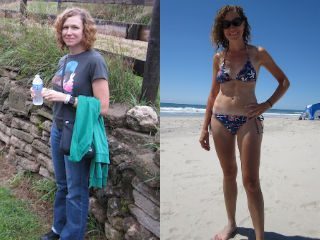 My previous before and after photos
My previous before and after photosI move almost constantly, but I no longer do chronic cardio. When I’m not trapped in an all-day meeting at work, I am up and out of my office chair at least every 30 minutes – getting water, going to the bathroom, or just taking a wide prasarita stance and typing at my keyboard. I don’t do a lot of focused “exercise.” But when I walk under our pull-up bar to get into the kitchen, I hang for a few seconds (working up to a pull-up one day). When I go the bathroom, I use the Squatty Potty. When I watch TV, I lay on the floor and constantly shift around. And when I’m in my office on a conference call, I do air squats or tree pose, or I massage my feet with Yoga Tune Up® Therapy Balls.
My anxiety levels are super low, my energy levels are super high (I rarely get the 2 P.M. crash anymore), and my weight and body composition are stable and healthy (courtesy of the better quality of food and constant movement).
I have developed a regular meditation practice. I still struggle to find time to do all the things I want to do in a day, but I try to carve out at least 10 minutes 5 days/week for a guided meditation. Thank you Insight Timer!!
Sleep – I almost always sleep well, and I sleep for 8 hours a night. Our bedroom is pitch black with no blue-light. Tim and I both read with our amber glasses on before bed.
The Challengeness
Seeing how much my heath has improved by changing the way I eat and move has seeded me with an intense desire to help others realize how much better they can feel if they take better care of themselves. For the past 4 years, I have been struggling with finding the best outlet for this desire. Last year I became a registered yoga teacher, and this year I trained with Jill Miller and became a Certified Yoga Tune Up® teacher (a modality I discovered through Mark and Katy’s collaboration on Don’t Just Sit There). I also completed a health coach certification program.
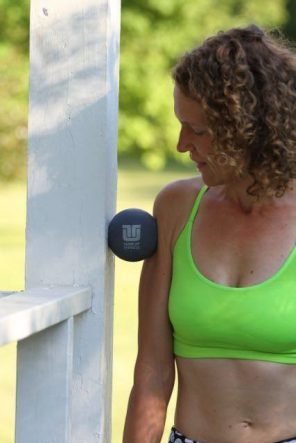 While teaching mindful movement gives me access to people who are looking for ways to become healthier and happier, I am constrained by my fear of not knowing enough to really help and also by my fear of letting go of my 8-5 job with benefits and structure, and security. My desire to help others as much as possible and share all the amazing things I have learned about the human body and psyche is currently at war with my desire for stableness, safety, and monetary security. So, yeah. That’s what I am figuring out now.
While teaching mindful movement gives me access to people who are looking for ways to become healthier and happier, I am constrained by my fear of not knowing enough to really help and also by my fear of letting go of my 8-5 job with benefits and structure, and security. My desire to help others as much as possible and share all the amazing things I have learned about the human body and psyche is currently at war with my desire for stableness, safety, and monetary security. So, yeah. That’s what I am figuring out now.
I set the intention in July to find my dharma (aka purpose – why was I put in this body, in this life, in this family, in this time), and now I have to live with the answers that have come up. TRUTH is inconvenient. For more on that, check out this Bliss & Grit podcast. Be careful what you wish for! Oddly enough, the Universe/Source/God does not really care about your coziness when it shows you your true path.
Once you get your diet, movement, and sleep in order, you are driven to get your spiritual house in order as well. That leads to a lot of soul searching and reading (books and books and books), and reflection. It is MUCH easier to just come home, eat supper, watch Seinfeld and go to bed. You don’t have to figure out: Does God exist? Is the Universe God? Am I a part of God? Am I put here for a reason? If so, do I have to uproot my safe life to fulfill that reason? How do I quiet my ego? How do I access my Witness self? Do I want to? Do I want to find out what issues are in my tissues, or should I let sleeping dogs lie? Do I want money or happiness? Or both? Can I be happy with just one? Ugh. The questions!! They never stop. And THAT is the challengeness. Thanks, Mark, for getting me to this point. And, yes, that is a *little* sarcastic. 
November 17, 2016
Promises and Limitations of the “Personalized Care” Movement: Where We Are Now
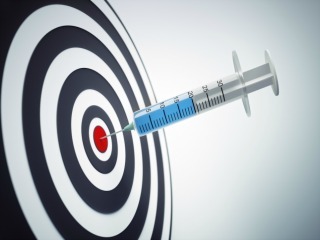 Several years ago, I gave my take on the “personalized care” movement: the broad push to use a person’s genetic data to design optimal therapies, treatments, interventions, and pharmaceuticals. I was supportive and hesitantly optimistic, but I also acknowledged the limitations and drawbacks. Yes, genetics do determine how we respond to different therapies, and we can optimize medical care using the information—if we understand what our genes are saying and how they interact with the environment.
Several years ago, I gave my take on the “personalized care” movement: the broad push to use a person’s genetic data to design optimal therapies, treatments, interventions, and pharmaceuticals. I was supportive and hesitantly optimistic, but I also acknowledged the limitations and drawbacks. Yes, genetics do determine how we respond to different therapies, and we can optimize medical care using the information—if we understand what our genes are saying and how they interact with the environment.
It’s only picked up steam. In last year’s State of the Union address, President Obama announced the Precision Medicine Initiative, pledging renewed efforts and funding to develop treatments tailored for an individual’s genetics, lifestyle, and environment. Businesses have sprung up promising to analyze your genetic data and create personalized workout routines, meal plans, and daily habits.
We’ve made big strides in personalized medicine.
We’re often able to fine-tune dosages of pharmaceuticals to avoid overdosing people with genetic sensitivities and under-dosing people with genetic resistance. It’s not exactly easy or fast, but it’s possible.
Researchers have identified genetic variants that increase statin-induced muscle damage. Doctors are choosing antidepressants based on a patient’s genetics (“pharmacogenomics”) and seeing a 53% improvement in reduction of depressive symptoms; they’re also using genetics to predict non-responding patients.
Since 2005, we’ve used genome-wide association studies (GWAS) to identify over 2000 “robust” associations between genetic variants and medical conditions and traits, many of which are predictive and medically useful.
Genetics determines how we react to different foods, nutrients, and exercising and feeding strategies. It can affect how much of each nutrient we need and how likely we are to become obese. We know a fair amount about how recent ancestry impacts optimal diet, including folate requirements, carb tolerance, and dairy sensitivity.
And because we contain far more microbial DNA than human DNA, analyzing the genomes of our gut biome could give us great insight into our immune, mental, and metabolic health.
There’s no “arrival.” There’s no perfect pinnacle of personalized medicine. It’s an uphill trudge with small wins and losses. There’s always something to learn and improve and overcome.
What are some current obstacles?
For one, there are very few “single genes.”
Most disorders and diseases (like cancer) are polygenic, not monogenic. Most traits (like height or cognition) are polygenic, not monogenic. Rarely will you find a perfect 1:1 match. This makes drawing actionable inferences from genetic data difficult. The more variables there are, the harder it is to discern the signal from the noise. `
Data is accurate. Analysis is lacking.
The genetic testing itself is very accurate. If you swab your cheek and send it off to 23andMe or DNAFit or Ancestry, the raw data is likely accurate. Where things break down is the interpretation of the data. When a blogger ordered genetic tests from several different companies, she got mixed results. The data was identical, but how each company interpreted the data differed substantially.
I’ve spoken glowingly of DNAFit in the past. And as far as the companies out there go, it’s probably the best one at analyzing the genetic data and providing actionable results. My own results matched what I’d experienced throughout my entire life of training and eating. And when the blogger notified DNAFit about some incongruities between their results and other companies’ results, they responded with a 2000 word justification of their interpretation of her data, complete with citations of the literature. The other companies either agreed to fix their mistakes or ignored her messages.
And, unfortunately, gut biome sequencing isn’t ready for prime time.
The gut biome is critical to our health. Sequencing and analyzing the members of a person’s gut biome could help us predict interactions with drugs and foods. It could give us a roadmap for feeding specific prebiotics, polyphenols, and other nutrients to target specific gut bugs. We’d know which probiotics to take to fill in any gaps. We could target baddies with the right antibiotics, rather than firebombing the entire gut. And we could compare our gut biomes to everyone else’s.
Unfortunately, popular testing services often differ in their results, and, assuming we have accurate results, they don’t tell us much about our health. We have rough associations between populations in the gut and some health conditions, but it’s not always consistent. Plus, we haven’t sequenced very many guts yet, so we’re flying blind.
The potential is clear. If we can identify all the genetic variants responsible for traits and untangle how they interact with environmental stimuli and lifestyle, we’ll have great control over our health and wellness. Throw in CRISPR, and things get even more interesting. We’re not quite there yet. There are lots of pieces, but they’re not in place.
It’s going to work though. Combining epigenetics, genetics, lifestyle, environment, the gut biome, ancestry, and high-powered technology will revolutionize medical care, nutrition, and fitness. I’m sure of it.
And as I’ve mentioned, personalized medicine is already viable in specific instances, like determining genetic drug tolerance and drug responsiveness, and identifying gene-disease associations. Is using your grandpa’s genetic data to determine his optimal coumadin dosage sexy or exciting? No, but it’s legit and utilitarian. And it proves that personalized medicine has a future.
But for now?
You’re still responsible for eating right, moving every day, playing as much as you can, lifting heavy things, getting out into nature, and all the rest. You can’t abrogate your agency. The promise of personalized medical care indistinguishable from magic at some future date doesn’t change that. No surprises there, of course.
I’m curious. Have you (or those you love) used aspects of personalized medicine? What’s been your experience? And whether or not you’ve had the opportunity to apply it to your own care, what’s your take on the personalized medicine picture—and emerging possibilities? Are you excited? Skeptical? Hopeful?
Thanks for reading, everyone. Take care.
The post Promises and Limitations of the “Personalized Care” Movement: Where We Are Now appeared first on Mark's Daily Apple.



November 16, 2016
Can You Harness the Placebo Effect For Yourself?
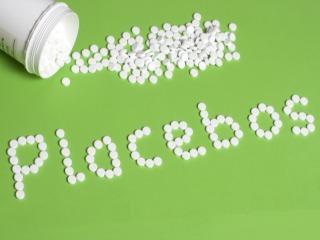 Every parent reading this has dealt extensively in placebo: the analgesic effect of the ouchie kiss. When your child bumps his head or skins her knee, the quickest way to ease the pain isn’t a Band-Aid, ice pack, or Tylenol. It’s a kiss. Works every time.
Every parent reading this has dealt extensively in placebo: the analgesic effect of the ouchie kiss. When your child bumps his head or skins her knee, the quickest way to ease the pain isn’t a Band-Aid, ice pack, or Tylenol. It’s a kiss. Works every time.
“But your kid only thinks it’s helping. You’re just tricking him.”
Maybe. So what?
In common parlance, “placebo” is a bad thing connoting uselessness, ineffectiveness, and treachery. Placebos are smoke and mirrors. Snake oil. Even the words clinicians use to describe the placebo arm of a trial—sham treatment, dummy pill, sugar pill—suggest placebo effects are nuisances impeding scientific progress. They’re inert. Their complete pharmacologically inactive nature defines them.
But I’m here to argue that the placebo isn’t just a necessary artifact of randomized controlled trials. It describes a very real effect that people can probably use to improve their lives.
First of all, there is no single placebo effect. There are placebo effects. We see them all over the health arena.
Physical pain: Many people assume the analgesic (pain-killing) effects of placebo are a re-interpretation of the pain sensation. The pain isn’t actually going away, they’re just handling it better in some non-corporeal way. That’s certainly part of it, but in 1978, researchers found evidence of a “real” mechanism for this placebo response: blocking the opiate receptors with a drug blocks the ability of a placebo to reduce pain. Later, placebo responders (people who get analgesic effects from placebos) were found to have higher levels of endorphins, the very same endogenous opiates that activate our opiate receptors.
Depression: Placebo seems to work about as well as conventional treatments in mild to moderate depression. The placebo effect may even explain why antidepressants (sometimes) work. In one study, taking a placebo for several weeks before taking an antidepressant made the antidepressant more effective.
IBS: One 2010 study found that placebo treatments can improve symptoms in IBS patients, even if they knew it was a placebo. That is, the researchers told the placebo arm that they were receiving a placebo pill, and it still reduced their symptoms. I have more to say about this later on, but for now, it’s evidence for placebo in IBS intervention.
Parkinson’s disease: Patients who took a placebo pill improved Parkinson’s scores, probably due to dopamine flooding the brain. Another study found that sham surgery (fake vs real implantation of human embryonic dopamine neurons) improved quality of life.
Joint pain: Several years ago, I linked to a study on “sham knee surgery.” That’s right. Patients with meniscus tears who qualified for knee surgery were randomized to either receive a real partial meniscectomy (where they actually cut into the knee) or a fake one (where they just mimicked doing it with real tools). Both groups did identical physical therapy regimens. Across 12 months of followup, both groups experienced significant and equal improvements.
“It’s just in your head.”
Again, so what? Every thought, feeling, emotion, and internal reaction our brains experience have a physical component and deal in biological substrates. Synapses fire, neurons connect, neurotransmitters shift. These are theoretically measurable. They’re real. If there is an ethereal soul somehow wedded to, but separate from, the physical body, we have no good evidence of it. My PubMed trawl came up empty.
So what explains placebos?
There is classical conditioning. The first four weeks of a study, you got an active painkiller in red gel cap form. At week five, they switched to a placebo that looked exactly like the painkiller—a red gel cap. Your body was conditioned to associate taking that red gel cap with pain relief, so it created the analgesic effect by releasing endorphins.
There are expectations. Many placebos are based on subconscious associations, contextual clues, and expectations. If you feel comfortable with a doctor, if you’re confident he/she cares about you, if you expect to be cured or helped, your brain will probably predispose you toward a positive response.
A new wave of research is showing that placebos work better when you give them the real treatment alongside the placebo first. Then you remove or reduce the dose of the active drug while keeping the placebo and retaining the effects.
Some researchers have even used this type of placebo conditioning to reduce the dosage of toxic drugs while maintaining the positive effects. A kidney transplant patient might take the active, highly toxic immunosuppressant alongside a very distinctive placebo (in one case, cod liver oil with essential oils). Each time she takes the drug, she sips the cod liver drink. The body figures out how to replicate or emulate the effect of the drug, by itself or at a lower dose.
If you can pull it off, the advantages of a placebo are obvious:
They’re less risky. Most “active” therapies confer some degree of risk, however small. “Inert” placebos have a much lower risk of causing unwanted side effects. They can facilitate lower doses of harmful treatments.
They’re getting stronger. All signs point to the placebo effect gaining strength in the population, with placebo controls performing better than ever against drugs. Yeah, it’s weird, but it could be a powerful ally if you can harness it.
Everything benefits from the placebo effect. If a doctor gives you an active drug, you’re getting both the placebo effect (the expectation that it will work) and the biological effect (whatever the drug’s designed to do).
But can you harness the placebo effect for yourself in your own life?
One wrinkle is that placebos work best when you don’t know it’s actually a placebo. I know, I know: everyone cites that IBS study where patients knowingly took “inert placebos” and still saw subjective improvements. They weren’t quite inert, though, because researchers told subjects the placebos might induce powerful “mind-body” effects that could improve their condition. A suggestion like that from a health authority figure can be very compelling. Telling a person “I’m giving you a sugar pill” without mentioning the mind-body potential likely wouldn’t have the same effects.
Another more recent “placebos work even when they know it’s a placebo!” study fell a bit short of the promise in the headline. Subjects were given a fake treatment, told it had no medical value whatsoever, and it still provided pain relief. However, they had to spend four weeks being convinced that it was biologically active, after which the ruse was revealed, for it to work as a placebo. That’s a placebo in that it doesn’t contain a biologically active pharmacological agent, but it’s also powered by the researchers’ conditioning.
Besides, it’s still another person—an authority—giving you the placebo. You can’t “give yourself” a placebo and hope for the same results.
Placebos don’t always work for every situation. They don’t seem to accelerate wound healing, for example. Placebos can help against cancer-related nausea and pain, but I wouldn’t trust one to shrink tumors.
Interestingly, your response to placebo has a genetic component. Certain variants of the COMT gene, which codes for dopamine metabolism, increase the effect of placebos. Other variants reduce or abolish it. Variants in genes involved with serotonin metabolism can predict a person’s placebo-induced anxiety relief. It’s possible (and likely probable) that other genetic variants affect other aspects of the placebo response, too.
But just because dosing yourself with sugar pills probably won’t improve IBS, anxiety, depression, or Parkinson’s without the right genes and a white coat conditioning you to believe doesn’t mean the placebo effect is useless.
What’s important is the expectation that something will happen. The belief that thought can alter matter. Not telekinesis or magic, but the simple acknowledgement that mental processes are biological.
Belief is the key here.
Scott Adams (of Dilbert fame) credits, or at least closely correlates major career milestones to the use of daily written affirmations. He’s not quite sure why (or even if) they work. He just knows they appear to for him. Maybe your subconscious opens itself up to opportunities that were always there. Maybe after writing them you just pay closer attention to anything that might help you reach your goal. Maybe the placebo-ish effect of belief in the power of whatever enables the affirmations to work makes you a better, more effective person.
Ultimately, believing in a cause greater than yourself might provide the biggest placebo effect of all. It could be a deity, a concept like honor/chivalry/bushido, your family, your business, your art. Anything at all should work, so long as it deserves your true loyalty and dedication. Don’t expect this kind of “placebo” to fix your bum knee. But it may create movement for a whole lot else that’s wrong in your life.
I’ll be frank. I’m not all that convinced an individual can revolutionize his or her life by “harnessing the power of the placebo.” Learning the placebo mechanism and trying to apply it to your life reminds me of explaining the joke: you ruin what made it work.
You know what could work?
Giving everyone else a little placebo love.
You already know, and you may have compromised your ability to placebo yourself. But they don’t have to know. They can still believe.
Many of you are coming from a place of authority in your immediate circle. You’re the person who everyone comes to for help with diet and exercise. When a buddy’s trying to decide between CrossFit and powerlifting, he asks your opinion. If your coworker wants to drop 15 pounds for her wedding, she asks you for advice. You’re the health person.
Own it. Give them confidence. Give them good advice and convince them it’ll work. That’s the placebo effect + active treatment effect.
Make them believe in themselves and what they’re doing.
That’s it for me today, folks. Let’s hear down below in the comment section:
What did I miss? Have you ever used the placebo effect on yourself—knowingly?
I know I have some brilliant readers. Let’s get some ideas flowing.
Take care.

The post Can You Harness the Placebo Effect For Yourself? appeared first on Mark's Daily Apple.



November 15, 2016
Introducing The New Primal Blueprint!
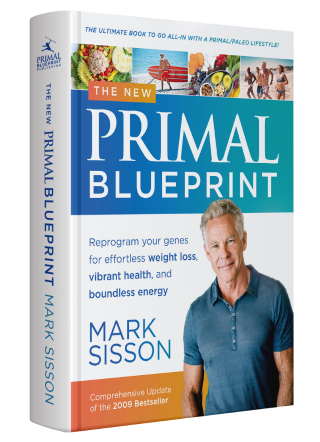 Greetings, readers. It’s time to announce the publication of another book—called The New Primal Blueprint. Recognize the title? Yes, this is a comprehensive expansion, revision and update of the original 2009 bestseller, and the official name is indeed The New Primal Blueprint! And no, it’s not a mere reprint with me wearing a newer shirt and older smile on the cover. This publication is the culmination of a massive six-year R&D project involving several staff members (especially Brad Kearns, Managing Editor and Primal Blueprint Publishing sidekick), a team of researchers, several of the world’s leading Primal/paleo authors and experts, and you—yes, processing feedback from the collective experiences of Primal enthusiasts over the past seven years.
Greetings, readers. It’s time to announce the publication of another book—called The New Primal Blueprint. Recognize the title? Yes, this is a comprehensive expansion, revision and update of the original 2009 bestseller, and the official name is indeed The New Primal Blueprint! And no, it’s not a mere reprint with me wearing a newer shirt and older smile on the cover. This publication is the culmination of a massive six-year R&D project involving several staff members (especially Brad Kearns, Managing Editor and Primal Blueprint Publishing sidekick), a team of researchers, several of the world’s leading Primal/paleo authors and experts, and you—yes, processing feedback from the collective experiences of Primal enthusiasts over the past seven years.
When I started this update/revision project over two years ago, my intention was to update the message, clean up some misunderstood topics, and cover some new ground on breaking subjects like gut health.
Alas, like many things we take on here in Primal-land, it ended up going big-time. And so I present to you a 584-page beast, full-color with extensive photographs, illustrations, cartoons, and graphs to deliver a most engaging and comprehensive read.
I can legitimately call this book my magnum opus, and I have no problem stating that this volume can stand as the ultimate comprehensive guide to living the Primal Blueprint lifestyle and gaining a total understanding what the Primal/paleo/ancestral health movement is all about. Even if you’ve read the original Primal Blueprint, I think you will get a kick out of this book and allow it to take the place of the original in your resource library.
As any devoted MDA reader knows, lots has changed in the last decade since the early days of the Primal/paleo movement. My team and I take pride in being open-minded, flexible, and adaptable to revising our positions and message in light of breaking science, as well as feedback from real live Primal enthusiasts. My favorite thing to do is dig into the research, engage with other thought leaders, evaluate feedback from Primal Blueprint enthusiasts and MDA readers, and carefully consider my stances to continually improve and chart an appealing course to health and happiness.
Thanks to events like PrimalCon, Paleo F(x) and the easy exchange of information over the Internet, I’m only a click or call away from the world’s leading experts on assorted subjects, and—believe me—I take advantage of my rolodex with unabashed questioning and debating when I’m compelled.
For example, Katy Bowman convinced me that increasing and varying everyday movement is just as important as a formal cardio regimen. Dr. Phil Maffetone convinced me that his “180-age” formula for aerobic maximum heart rate is the end-all calculation to develop a fat-burning beast and avoid the perils of chronic cardio. Kelly Starrett convinced me that devoting time to flexibility/mobility is just as important to fitness as hitting the gym and the sprints regularly. Finally, Dr. Cate Shanahan helped me become a little more flexible in my promotion of the values on the Primal Blueprint Carbohydrate Curve to allow for individual variation and optimization of carb intake—especially for females wishing to avoid thyroid and hormonal problems relating to sudden and extreme carb restriction after decades of high-carb eating.
In this post, I’ll provide details and rationale for the recent revisions to the Primal Blueprint Food Pyramid and Primal Blueprint Fitness Pyramid, as well as discuss some key areas of the new book that have been expanded or revised from the original hardcover Primal Blueprint in 2009 and the paperback update in 2012.
See what you think, and feel free to comment—I read and consider them all!
2016 Food Pyramid

The new bullet points attempt to provide an at-a-glance education about the benefits of Primal eating. We’ve done a bit of tidying up of the descriptions and benefits in the food categories but no major policy shifts or big surprises. On account of de-emphasizing the O6:O3 ratio concerns relating to healthy foods like nuts (more shortly), I emphasize the Primal Blueprint’s acceptance of all nuts and seeds, toning down the previous distinction of macadamia nuts as superior because they are higher in monounsaturated fat (and lower in omega-6 fats) than other nuts and seeds. Supplemental carbs for athletes is renamed to “high nutrient value carbs”—an acceptable choice for anyone who feels the need for these foods and additional dietary carbs in general.
2016 Fitness Pyramid
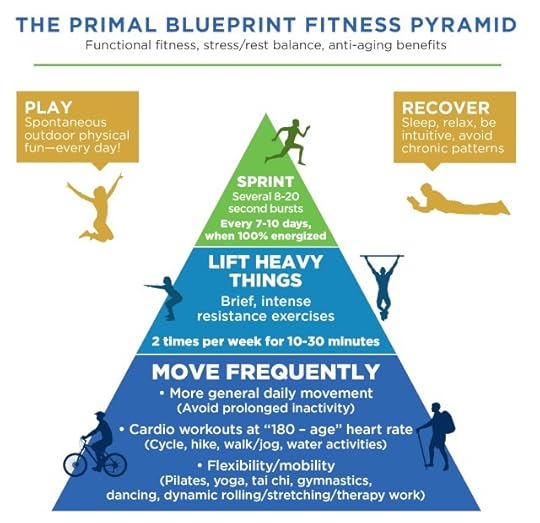
The main revision here was to rename Primal Blueprint Law #3 to “Move Frequently” instead of the previous “Move Frequently at a Slow Pace.” Previously, my Law #3 message emphasized doing aerobic workouts at the proper heart rate, with only a casual mention of the importance of moving around more in daily life. The new pyramid makes an effort to broaden the concept of Move Frequently to emphasize not only structured cardio workouts, but general everyday movement and the assorted physical endeavors categorized as Flexibility/mobility.
In today’s sedentary world, moving more is everything. The active couch potato syndrome is the real deal, and it ain’t pretty. In short, even if you are devoted to fitness with a faithful daily slog on the road or trip to the gym, you aren’t immune to the negative effects of lengthy stretches of inactivity—commutes, desk jobs and digital entertainment leisure time. The new Flexibility/mobility section is where those complementary fitness activities enter the picture: Pilates, yoga, tai chi, gymnastics, dancing, self myofascial release with rollers and balls, general stretching, and customized mobility/physical therapy exercises to address your particular prevention or healing concerns.
Regarding the optimal heart rate for aerobic activities, we’ve decided to depart from calculations based on maximum heart rate (Previously, the Primal Blueprint specified 55-75% of max heart rate as the aerobic exercise zone) and instead promote Dr. Phil Maffetone’s 180-age = maximum aerobic heart rate formula. Dr. Maffetone is the undisputed leader in this realm, and his formula is easier and more effective than calculating exercise intensity off of maximum heart rate. There is too much potential for error going off max heart rate, especially overestimating your aerobic limit.
Primal Endurance goes into great detail on this concept, because it’s so important for everyone who does cardio to essentially slow down and ensure they are burning fat, instead of allowing heart rate to creep up, introduce more glucose burning and stress hormone production into supposedly comfortable workouts and—over time—drift into a destructive chronic exercise pattern.
It’s pretty simple: subtract your age from 180, get your magic number, and honor that limit during your cardio sessions. (There are some adjustment factors for certain individuals, detailed in Primal Endurance or in Dr. Maffetone’s work.) You will likely have to slow way down from the typical indiscriminate pace of most joggers, cyclists and gym equipment users. By doing so, you will experience what it’s really like to become an efficient fat burner instead of being overstressed and carbohydrate dependent.
“Lift heavy things” and “sprint once in a while” stand strong as the preferred exercises to build or preserve lean muscle mass, optimize fat metabolism and hormonal function, promote organ reserve, and support bone density.
Various types of strength training—from the simple Primal Essential Movements to Jacques Devore’s cutting-edge Maximum Sustained Power training—work for Lift Heavy Things, but you have to put your body under load regularly to stay strong.
Similarly, sprinting once in a while stimulates that desirable brief fight-or-flight response, the spike of adaptive hormones like growth hormone and testosterone coursing through your bloodstream, and helps you blast through body composition plateaus like no other exercise. When you sprint, even just once in a while, you become stronger and more resilient in mind and body—not only for sprinting, but also for all types of exercise at lower intensities.
The New Primal Blueprint: Other Updates and Revisions
Here are several other topics from the book that are additions or revisions from the original publication.
Chapter 1 – Shout out to the hatahs: I spent a little time clarifying my position against detractors who have misinterpreted the Primal Blueprint as me manipulating evolutionary science into a regimented program. I totally appreciate experts with carefully considered opinions and health approaches that differ from mine. Heck, my old buddy from the professional triathlon scene, Rip Esselstyn, is killing it with his Engine 2 Diet and line of food products seen at Whole Foods. We differ on material matters like the role that whole grains and saturated fat play in healthy eating, but by and large this guy is motivating and inspiring people to be “plant strong,” so all the power to him.
However, when the book Paleofantasy attacks the paleo diet as a farce because our ancestors ate all kinds of different diets, or when the book Cult Diets asserts that because no single diet is a perfect fit for everyone that Primal/paleo is ill-advised, I say: “Wait a sec, man!” These are exactly the arguments I make as to why regimented diets are illogical—and why I insist that we must discover our own optimal eating habits within the framework of evolutionary health principles.
Chapter 1 – Genetics: I have provided further clarification for the rationale that we should model our lifestyle behaviors after our hunter-gatherer ancestors for purposes relating to health and directing optimal gene expression because we are genetically identical to them. This assertion is often misinterpreted, and examples that “humans are still evolving” are bantered about.
Really, we are getting into a semantic argument when we consider the effects of genetic drift and global population expansion on the human genome. I discuss the interesting examples of rapid genetic changes like lactase persistence among those of herding ancestry, the lightening of skin pigment for those migrating further from the equator (believed to have happened between 40,000 and 10,000 years ago—after a couple million years of humans being black), and the varied ability to digest starch based on prevalence of the AMY1 gene (a salivary enzyme). Gene expression is still strongly influenced by the environment, and there is no selection pressure to stimulate true DNA change in the manner of Darwinian evolution (I explain this further in case it’s been a while since middle school science class).
Another addition addresses the idea bantered about that humans might be devolving from adverse modern lifestyle practices. Again, we are not technically de-evolving, but a growing body of research suggests that genetic changes caused by environment can be passed to offspring through epigenetic transgenerational inheritance. Yep, binging on ice cream during your pregnancy can promote insulin resistance in your little one. Scary stuff, but again a confirmation that we are in control of our gene expression by making the right diet, exercise and lifestyle choices.
Chapter 1 – Primal/paleo rationale: A commonly cited paleo litmus test is if a food didn’t exist 10,000 years ago, you shouldn’t eat it—the rationale being that we have not had sufficient time to adapt genetically to “modern” foods. This assertion usually makes sense, but it is not stand-alone valid.
The reason we should not eat certain modern foods like grains, sugars and refined high polyunsaturated vegetable oils is because they are unhealthy, not necessarily because we haven’t genetically adapted to them. Hence, I had to do a bit of cleanup on my breezy language from years ago to highlight this distinction. Recall, however, that I have from the start taken a more relaxed approach than traditional paleo dogma, arguing that certain modern foods are acceptable to consume because they offer nutritional benefits and no health objections—like high-fat dairy products and dark chocolate.
Furthermore, throughout evolution, humans have encountered brand new foods that we have not genetically adapted to, but that are healthy, and we have thrived consuming them. Thanks, Matt LaLonde, for pressing this point very well in recent years.
Another message cleanup (thanks, Tracy Kearns, for the challenge) came during the frequent mention of the evolutionary model as inspiration for peak performance and longevity today. This is a bit of a stretch, or literal disconnect, because the ultimate goal of evolution is simply to survive long enough to reproduce. Since any video-gaming, candy-chomping teenager can reproduce just as successfully as an Olympic sprinter or PhD mathematician, surviving to reproductive age is not a lofty accomplishment today.
Instead, we must appreciate the nuance of applying the evolutionary model to make lifestyle decisions that honor our genes, but taking the spirit of the Primal Blueprint many steps further in order to promote longevity, happiness and management of the unrelenting stress of modern life.
Cases in point: the orthorexia phenomenon warns us that it’s not good enough to eat foods off the “yes” list and avoid foods on the “no” list; you have an obligation to yourself and your loved ones to enjoy the process of healthy eating and experience the joy and complete satisfaction provided by nutritious foods and celebratory meals (shouldn’t every meal be a celebration? It was for our ancestors). Similarly, over-exercising (even if it’s moving frequently, lifting heavy things, and sprinting once in a while) might generate a sequence of short-term positive gene expression events, but will lead you right to burnout instead of happiness and longevity.
Bottom line: I encourage you to live according to the Primal Blueprint principles, but I insist that you enjoy yourself along the way!
Chapter 3 – Omega-6:Omega-3 ratio: The dietary omega-6:omega-3 ratio has long been a hot topic in Primal/paleo circles. The basic notion is that we consume vastly excessive amounts of omega-6 in relation to omega-3. This imbalance promotes inflammation in the body because omega-6s deliver a pro-inflammatory effect and omega-3s are the anti-inflammatory powerhouses. Unfortunately, the concept has been oversimplified to the extent that omega-6s are seen as “bad.”
The true concern is that many unhealthy foods are high in omega-6, such as refined high polyunsaturated vegetable oils and packaged grain-based snacks and prepared meals. The problem is not the consumption of omega-6 per se, but the consumption of those unhealthy, pro-inflammatory foods that are high in omega-6. Furthermore, pro-inflammatory mechanisms in the body are critical to health; the key is to keep inflammation in balance, not to suppress inflammation in general. While it’s a good idea to obtain ample amounts of dietary omega-3 (the main dietary source is oily, coldwater fish), there is no reason to eschew healthy sources of omega-6 (nuts, seeds, nut butters) in the quest to improve your ratio.
Chapter 4 – Optimal protein consumption: The long-standing consensus recommendation for average daily protein intake (supported by both The Primal Blueprint and mainstream dietary resources) is now being called into question by respected primal/paleo types as it might be an overestimation, and detrimental to our health. It’s obvious that we must meet our minimum needs to ensure the health of our tissues and organs. Otherwise we enter a catabolic state, break down lean muscle mass and compromise immune function. That minimum need to support basic metabolism is agreed to be around .5 grams per pound (1.1 grams per kilogram) of lean mass.
From there, most resources promote the idea that your protein requirements escalate according to your activity level. So calculating off the basic requirement of .5 grams, a moderately active person might want .7 grams per pound (1.5 grams per kilo), while a highly active person is recommended to reach one gram per pound (2.2 grams per kilo) to ensure adequate health and recovery from exercise.
Dr. Ron Rosedale, a leading voice in the concerns about excess protein, suggests that .5 grams of protein per pound of lean mass is plenty for everyone. He believes that even high protein demand people (the highly active, growing teens and pregnant women) need only add 5-10 grams per day to that calculation to ensure optimal protein intake. When you slam your body with excess protein—more than it needs to fulfill the growth and repair functions that are the primary uses for protein—it works hard to either excrete it or convert it into carbohydrates via gluconeogenesis, which are then used for energy (or, if you’re in a calorie surplus, stored as fat).
The conversion of excess protein into glucose will compromise your fat-loss goals, and essentially turn anything considered a high-protein diet into a high-carbohydrate diet in reality (due to gluconeogenesis). What’s more, excess protein consumption continually primes you for accelerated cellular division and growth, instead of the more natural pattern of varying between anabolic (repair, rejuvenation, growth), catabolic (breakdown from exercise and life stressors) and metabolic (normal chemical reactions producing energy).
Chapter 4 – Carbohydrate intake: There’s been some pushback against adhering to a strict low-carb paleo eating pattern as many enthusiasts, especially females, have reported adverse effects from cutting carbs. A sudden and/or significant reduction in carbohydrate intake has been blamed for thyroid problems, fatigue, and even disturbances in gut health. While there is never any rationale to consuming refined, nutrient-devoid carbs like grains, sugars and sweetened beverages, the inclusion of high nutrient value carbohydrates into the diet is certainly acceptable by the Primal Blueprint.
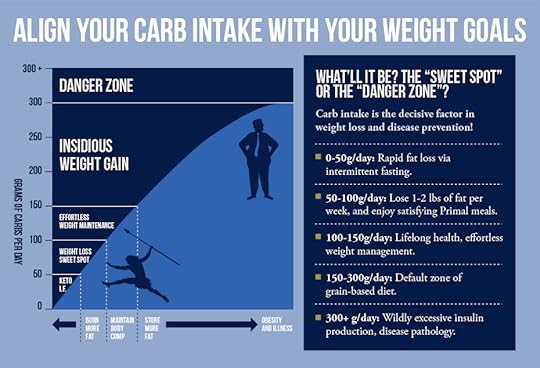
The level of your intake is probably best determined by personal preference. That said, the widely adopted Primal Blueprint Carbohydrate Curve will still accurately predict your success or failure with reaching and maintaining your ideal body composition. If you are interested in losing excess body fat, the surest path to get there is to reduce total carbohydrate intake, which reduces insulin production and enables you to access and burn stored body fat. The upper limit of the maintenance range is 150 grams per day, which allows for an abundant intake of vegetables, sensible intake of seasonal fruit, and an ample amount of incidental carbs from primal-approved foods like nuts, seeds and dark chocolate.
What I used to call “Supplemental carbs for athletes” is now called “High nutrient value carbs.” This category includes sweet potatoes, squash and other starchy tuber vegetables, wild rice and quinoa. My effort here was to reposition the big picture on carb intake to be less strict and more left to personal preference.
If you are trying to lose excess body fat, the most direct path is to moderate carb intake. There is no call for anyone to consume grains, sugars, sweetened beverages or other highly processed, high-carb fare, ever.
Chapter 4 – Ketones: With ketogenic eating and endurance training being such a hot topic today, the discussion has been greatly expanded. In particular, I emphasize how glucose burns “dirty” in your body, creating considerable metabolic waste products, inflammation and oxidative damage; while fat and ketones burn “clean.” Glucose is metabolized quickly and easily for energy, but mitochondria and oxygen are not required for glucose burning. Hence, you can lose out on the free-radical protection that mitochondria provide during calorie burning.
When you are locked in a carbohydrate dependency diet, your mitochondria can actually atrophy. This atrophy increases your susceptibility to all forms of oxidative stress, not just from diet but also from chronic exercise, pollution and the stress of hectic modern life. Note: glucose can also be burned with oxygen and mitochondria, but even then more free radicals are generated in comparison to burning fat and ketones.
The best way to optimize mitochondrial function and protect yourself against general free radical damage is to become fat- and keto-adapted. Utilizing lots of oxygen and mitochondria to metabolize calories, requiring fewer calories to survive (because insulin and hunger hormones are moderated when you are fat adapted), engaging in Intermittent Fasting, and dipping into that rarified state of ketone burning—even if it’s just occasionally—all support mitochondrial biogenesis. Mitochondrial biogenesis is the manufacture of additional mitochondria (and optimizing the functioning of existing mitochondria) to better diffuse the oxidative stress of burning calories and simply being a living, breathing human.
Ketone burning has been shown by science to facilitate rapid fat reduction, improve the function and development of mitochondria (the energy centers of our cells), exert a potent anti-inflammatory effect, improve immune function, boost cellular repair, control epilepsy, deliver assorted benefits to cognitive function (especially for those with dementia, autism and ADHD), and even fight cancer (by starving cancer cells of their main fuel, glucose.)
Check out The Art and Science of Low Carbohydrate Living by Dr. Steven Phinney and Dr. Jeff Volek for a comprehensive education with scientific detail about the wonders of ketones for the aforementioned conditions, and watch Dr. Dom D’Agostino’s TEDx Talk “Starving Cancer” for details on that subject. Interestingly, the therapeutic benefits of ketone burning have prompted the manufacture of consumable sources of ketones, allowing one to override the delicate macronutrient restrictions and achieve elevated blood ketone levels.
Chapter 5 – Prebiotics and probiotics: This all-new section details the burgeoning health concept that connects the state of the bacteria in your intestinal tract to various diseases, and how many doctors now consider microbial diversity (how many different types of gut microbes you have—more is better) to be an important health marker. The immune system in particular depends upon a healthy balance of bacteria in the gastrointestinal tract, a state characterized by a predominance of “friendly” bacteria over the “bad” bacteria that can cause illness.
Contrary to the oversimplified layman’s view of germs and bacteria as universally bad and dangerous, our bodies are constantly covered and populated by all manner of germs and bacteria, both good and bad—no matter how hard we try to scrub and cleanse everything we eat and touch.
Beneficial bacteria are the most important line of defense for your immune system. They help quell inflammation, neutralize toxic substances, turn fiber into special health-promoting fatty acids, and even produce important nutrients like B vitamins and vitamin K. Interestingly, 90 percent of the production of your body’s critical “feel good” neurotransmitter serotonin happens in the gut, regulated by intestinal enterochromaffin (EC) cells and other forms of intestinal bacteria. Gut microbes also produce other adaptive hormones like dopamine and noradrenaline.
In this lengthy section, I talk thru the particulars of probiotics (fermented foods such as yogurt, kefir, sauerkraut, pickles, kimchi, fermented soy products like miso and tempeh), kombucha drinks and even dark chocolate) and also explain how prebiotics (aka resistant starch such as potato starch, cooked and cooled rice or potatoes, or green bananas) are metabolized by bifidobacteria in the colon into a short-chain fatty acid called butyrate—the prime energy source for your colonic cells. Butyrate communicates with your immune system, helping to regulate inflammatory processes. Resistant starch consumption has also been shown to boost insulin sensitivity, improve the integrity of your gut lining (combating the aforementioned leaky gut), reduce fasting blood sugar levels, and lessen the glucose and insulin responses to high-carb meals.
Chapter 6 – Hydration: The original Primal Blueprint position was to simply obey your thirst. Indeed, your body’s thirst mechanism does an excellent job dictating when and how much to drink, and your kidneys do an excellent job regulating fluid balance in your body even when fluid intake is not ideal.
It’s difficult to become dehydrated, because your thirst mechanism kicks in big time long before you reach a level of dehydration where your health is at risk. There is a much greater risk of hyponatremia these days—an overconsumption of fluid such that your sodium levels are dangerously diluted. There have been several reported cases of inexperienced marathon runners hydrating obsessively to the extent that they became comatose or died from hyponatremia.
Here’s the thing: it’s difficult to become dehydrated, but for ambitious fitness enthusiasts or those performing work in hot climates, it’s possible to mute the ideal function of your thirst mechanism and get into a pattern of insufficient fluid intake and some minor, perhaps chronic, level of dehydration.
The work of Dr. Stacy Sims at Stanford and the aggressive promotion of hydration as a more nuanced concept by Dr. Kelly Starrett, author of Becoming a Supple Leopard and Deskbound and purveyor of MobilityWOD.com, have been instrumental as I’ve refined my position to offer some strong caveats and elaboration from the oversimplified, “obey your thirst, like Grok” initial position.
Optimal hydration is about being sensible and strategic in addition to being highly aware and responsive to your thirst mechanism. Furthermore, it’s critical to pay attention to your sodium balance to the extent that optimal hydration entails not just slamming water, but including a bit of salt with each serving. It’s been found that adding a bit of carbohydrate to your fluid can enhance absorption. That said, there is no call to go purchase popular energy or sports drinks that are typically grossly excessive in carbohydrate intake. You can simply prepare a pitcher or bottle of water and add a pinch of salt and perhaps a few drops of honey or other sweetener and do just fine. Anything beyond a bit of carbohydrate will actually slow absorption in the intestines.
Folks, there are plenty more improvements you will appreciate as an original Primal Blueprint reader, so much so that I really encourage you to update your library with this new volume and give it a read.
I have a collection of my favorite go-to books that I read over and over (perhaps I’ll do a post on this someday, hmmm…) as I believe we retain less information than we realize, and that repetition of the really important stuff is the best way to master material. Besides, with the colorful photos, drawings, charts and graphs, it’s fun to just sit down and skim through pages and let the Primal Blueprint wash all over you. Check out the special offer below and consider “upgrading” your library, or going all-in for the first time, with The New Primal Blueprint.
Enjoy an excerpt here.
Per Mark’s Daily Apple tradition, I’ve put together an exciting limited-time offer for my new book release.
Order one or more copies of The New Primal Blueprint from Amazon.com in either Kindle or hardcover format by Nov. 23, then fill out this form, and you’ll get the following bonus items for FREE:

A coupon for a free bottle of PRIMAL KITCHEN™ Ranch dressing at PrimalBlueprint.com: Use this coupon to pick up a FREE bottle of our newest PRIMAL KITCHEN™ creation and the holy grail of dressings: ranch! This dairy-free ranch is an uncompromisingly delicious, rich, full-flavored, and oh, so healthy dressing. Using 100% pure avocado oil as a base, our ranch includes only the finest health-enhancing, all-natural ingredients, including organic garlic, onion, dill, cage-free organic eggs, black pepper and chives. And that means no dairy, no buttermilk, gluten, soy, canola or sugar in sight. So go ahead and finally enjoy your childhood favorite again! No guilt here.
A digital download of The Primal Slow Cooker Cookbook: I know you folks are busy with the kids and work and workouts, so I’ve put together this collection of broths and slow-cooked, nutritious and delicious meals that will be ready for eating when you walk through the door. Enjoy creations like Chicken Adobe with Coconut Aminos, and Tender Braised Brisket with Caramelized Onions and Tomatoes.
How’s that for a bonus bundle?
Just click here to grab your copy of The New Primal Blueprint on Amazon and fill out this form here to get your free bonuses.
FINE PRINT
This special bonus offer ends at 11:59 pm, Nov. 23, 2016 (PST).
All receipts must be received by 11:59 pm, Nov. 24, 2016 (PST). The forms will stop working on Nov. 25, so be sure to fill out the form and submit your pre-Nov. 23 receipt(s) by then.
On an iPhone? You won’t be able to upload your receipt from it, unfortunately. You’ll have to use a computer.
You will receive access to The Primal Slow Cooker Cookbook and your PrimalBlueprint.com gift certificate via email within 24 hours.
Pre-orders will be honored for all bonus offers.
Both orders placed online (from any source) and in brick and mortar retail locations will be honored.
Both domestic (U.S.) and international orders are eligible for the bonuses.
All book formats are eligible, including physical books and digital versions (e.g. Kindle).
The PrimalBlueprint.com gift certificate expires on December 23, 2016, and is valid for a single use on one bottle of PRIMAL KITCHEN™ Ranch dressing, you just pay S&H.

The post Introducing The New Primal Blueprint! appeared first on Mark's Daily Apple.



November 14, 2016
Dear Mark: Transdermal Magnesium and Vitamin D/B12 Products for a Vegetarian
 For today’s edition of Dear Mark, I’m answering two questions. The first one concerns transdermal magnesium. Does it work? Can magnesium actually permeate the skin and enter circulation? Probably. And for the last question, I provide a bunch of examples of natural products—foods and behaviors—that can increase vitamin D and B12 levels for an ailing vegetarian.
For today’s edition of Dear Mark, I’m answering two questions. The first one concerns transdermal magnesium. Does it work? Can magnesium actually permeate the skin and enter circulation? Probably. And for the last question, I provide a bunch of examples of natural products—foods and behaviors—that can increase vitamin D and B12 levels for an ailing vegetarian.
Let’s go:
Mark, what’s your two cents on transdermal magnesium? I take between 200-600 mg mag glyconate daily. I then add mag chloride via ‘magnesium oil’ to my shoulders and anywhere my muscles are tighter than usual. Anyone else use the mag oil or gel?
I like it.
If you rely solely on the scientific literature, there isn’t a ton of strong evidence. But there is evidence.
In one study (PDF), subjects took daily 12-minute epsom salt (containing magnesium sulfate) baths for a week straight. After a week, magnesium levels had risen significantly in most subjects. Those who’d already had replete magnesium levels saw their urinary excretion increase, suggesting that excess magnesium does get absorbed but not retained. Epsom salt baths also provide bioavailable sulfate, a hugely important but underappreciated mineral in our physiology.
Topical magnesium chloride (the kind used in magnesium oil) has also been shown to increase serum levels of magnesium in human subjects (PDF). Subjects were given 20 sprays of magnesium chloride to the body and took a 20-minute foot bath in a magnesium chloride solution. They did this every day for 12 weeks. Hair mineral analysis showed that participants increased magnesium levels by nearly 60% and improved their calcium:magnesium ratios. I don’t know how else you’d explain the results if the magnesium isn’t being absorbed.
A study from earlier this year found that magnesium ions can permeate through human skin using the hair follicles.
And topical magnesium does something. Plenty of studies suggest this.
Adding magnesium oil to calendula cream sped up infants’ recovery from diaper rash.
Women with fibromyalgia were given magnesium chloride oil and told to apply 4 sprays to each limb twice a day for 4 weeks. By study’s end, pain and other fibromyalgia symptoms had improved.
The whole premise of Dead Sea Salt therapy is predicated upon the minerals passing through the skin. And it works.
I don’t use it all the time, but I have noticed that spraying magnesium chloride oil several times on my rib cages and inner arms before bed gives me extremely vivid dreams. Is it “good” or “beneficial”? I don’t know. But the effect it has on dreams—plus the way it causes skin to tingle where applied—suggests the mag-chloride is bioavailable.
I’m not sure how “necessary” topical magnesium is. But if it is important, it’s probably emulating the ancestral environment, where we often bathed, frolicked, and swam in high-magnesium water.
Hi Mark, I am a regular visitor of your website and love your tips. Can you please help me with some natural products which can help in increasing vitamin D and B12. My husband is a vegetarian and suffering from severe deficiency of these vitamins. – Anita Gupta
In severe deficiency, you need to shore things up with a supplement. Vitamins B12 and D are extremely important for neurological health, immune function, cancer prevention, and maintenance of basic health. You don’t want to mess around.
There’s a chance your husband has impaired intestinal B12 absorption. In that case, try 1 mg/day of sublingual methylcobalamin, which will bypass the intestinal tract and pass directly into the bloodstream. Chris Kresser has a lot of experience treating B12 deficiencies in vegetarians, and his recommendations will probably help.
Okay, natural products? Let’s go. Not all will be vegetarian (I have many readers for whom this info is useful), mind you. But I also won’t be recommending fermented bull blood or anything so egregiously carnivorous.
For vitamin D…
Sunlight: UVB light is a “natural” substance “produced” by the sun, so I’d say it qualifies. Midday sun has the most vitamin D-producing UVB light. Be sure to sun safely and effectively though. That means getting plenty of sleep, eating lots of phytonutrients, emphasizing monunsaturated and saturated fats over polyunsaturated fats, and getting some omega-3s every day.
Sunbathing mushrooms: Mushrooms turn sunlight into vitamin D2. I’m serious here. Scatter a handful of fresh mushrooms across a cookie sheet and place it in the midday sun for up to two days.
Egg yolks: A pastured egg yolk contains about 10% of your vitamin D RDI. I’ve seen high levels (250 IU per egg) in brands of “engineered” eggs, where the chickens are given highly structured diets of algae, specific grains, and other ingredients to boost nutrients.
Grass-fed raw milk: Cows naturally pick up vitamin D being out on the range exposed to the sun, and it shows in the milk. But the pasteurization process significantly reduces the vitamin D content of milk. If your husband eats dairy, try raw for awhile.
On the off chance that your husband is a pescetarian:
Cod liver oil: Most cod liver oils these days replace the naturally-occuring vitamins D and A with synthetic ones. Those are better than nothing, but it’s more preferable to use a cod liver oil that still contains the natural compounds. Dropi, Sonne’s, NutraPro, and Rosita’s cod liver oils all contain the natural vitamins. Fermented cod liver oil is another choice, albeit one with a lot of controversy.
Sockeye salmon: Wild sockeye salmon is extremely high in vitamin D, with a single filet providing almost 1000 IUs.
Sardines: Sardines provide about half the vitamin D as salmon, but that’s a lot better (and less expensive) than other fish.
For B12…
Egg yolks: A pastured yolk is going to have more B12 than a standard yolk. And again, I’ve seen those same engineered eggs with about 2-3x the B12 content of regular yolks.
Oysters, mussels, and clams: Bear with me here. Hear me out. Oysters and other shellfish do not have central nervous systems capable of perceiving what we call pain. And they are incredible sources of vitamin B12. If you can get over the fact that they are technically animals, you can get enough B12 for the week with a few ounces of clams.
That’s about it for today, folks!
If you’ve got anything to add to my answers, leave it in the comments below!
Thanks for reading.

The post Dear Mark: Transdermal Magnesium and Vitamin D/B12 Products for a Vegetarian appeared first on Mark's Daily Apple.



Mark Sisson's Blog
- Mark Sisson's profile
- 199 followers




